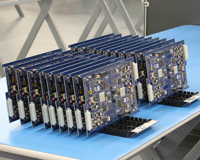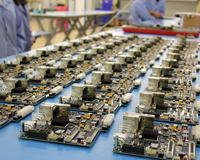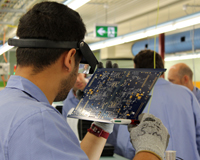Industry collaboration leading to big things
14 November 2014
Through the ASKAP project, CSIRO is working with Puzzle Precision, a a quality, high-reliability electronic assembly service, to jointly develop and produce sophisticated electronic circuit boards and major components of the telescope's digital systems.
What started as 30-40 boards manufactured for CSIRO’s Compact Array Broadband Backend (CABB) project has now grown to thousands of units of work required for ASKAP’s innovative phased array feed (PAF) receivers and associated digital systems.
According to ASKAP Project Director Ant Schinckel, a project on the scale of ASKAP relies on industry to provide expertise in production, construction, installation and commissioning to meet demanding quantity and quality requirements, and introduces technical challenges that must be overcome in the design and construction of the telescope’s components.
“The ability of Puzzle Precision to meet the stringent demands of the ASKAP electronic boards design demonstrates how small industry partners can provide useful solutions to meet the production demands and scientific grade standards of highly technical equipment,” says Ant.
“While ASKAP is being developed by CSIRO scientists and engineers, support from industry specialists brings together local and international expertise in production, construction, installation and commissioning.”
Recently Puzzle Precision has opened new production facilities in Newcastle, NSW, equipped with an increase in mechanical assembly capabilities. Some of the ASKAP team visited the facility to see the expanded capability and also mark the commencement of production build for the Mk II ASKAP PAF receivers’ electronics boards and digital systems.
Throughout the various stages of the ASKAP project, industry engagement is vital to research and development, prototyping, testing and ultimately production of the antenna and receiver system components, processing electronics and support structures.
Industry participation has created strong collaborations with a variety of organisations, from smaller local suppliers to larger technology and civil engineering firms, as well as niche R&D companies.
Not only do the benefits of collaboration include technology transfer across astronomy and industry, enhanced capability for Australian industry and access to new technologies, but solutions to non-astronomy challenges will also have applications on a global scale.
Back to Latest ASKAP News page.



